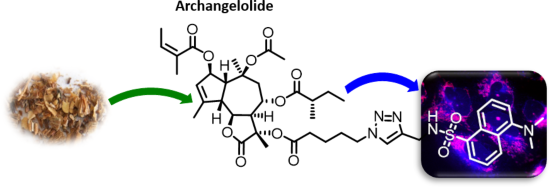Search results
Search for "guaiane" in Full Text gives 8 result(s) in Beilstein Journal of Organic Chemistry.
Functional characterisation of twelve terpene synthases from actinobacteria
Beilstein J. Org. Chem. 2023, 19, 1386–1398, doi:10.3762/bjoc.19.100
- in sesquiterpene biosynthesis that can be reactivated by reprotonation for a second cyclisation to eudesmane (6,6-bicyclic) or guaiane (7,5-bicyclic) sesquiterpene hydrocarbons or alcohols, respectively [46][47]. Starting from 26, such a protonation induced cyclisation can lead to C that is the
Germacrene B – a central intermediate in sesquiterpene biosynthesis
Beilstein J. Org. Chem. 2023, 19, 186–203, doi:10.3762/bjoc.19.18
- Houchao Xu Jeroen S. Dickschat Kekulé-Institute of Organic Chemistry and Biochemistry, University of Bonn, Gerhard-Domagk-Straße 1, 53121 Bonn, Germany 10.3762/bjoc.19.18 Abstract Germacranes are important intermediates in the biosynthesis of eudesmane and guaiane sesquiterpenes. After their
- initial formation from farnesyl diphosphate, these neutral intermediates can become reprotonated for a second cyclisation to reach the bicyclic eudesmane and guaiane skeletons. This review summarises the accumulated knowledge on eudesmane and guaiane sesquiterpene hydrocarbons and alcohols that
- - (selinane) or 5-7-bicyclic (guaiane) sesquiterpenes. We have recently summarised the accumulated knowledge about sesquiterpenes derived from germacrene A (2) [12] and hedycaryol (3) [13]. Now we wish to provide a review on the known chemical space of sesquiterpenes derived from germacrene B (1) (Scheme 2
The enzyme mechanism of patchoulol synthase
Beilstein J. Org. Chem. 2022, 18, 13–24, doi:10.3762/bjoc.18.2
- . (Scheme 2) [10] DFT calculations have been performed previously by us as part of a general study on guaiane sesquiterpenes from germacrene A (8) [29]. After reprotonation of the neutral intermediate 6 to F the next cyclisation to G and Wagner–Meerwein rearrangement to D can be realised with low TS
Combining enyne metathesis with long-established organic transformations: a powerful strategy for the sustainable synthesis of bioactive molecules
Beilstein J. Org. Chem. 2020, 16, 738–755, doi:10.3762/bjoc.16.68
- , respectively, by domino metathesis reactions using the Hoveyda–Grubbs catalyst (4 mol %). In the final step, (−)‐clavukerin A was effectively converted into (+)-clavularin A and the latter epimerized to (−)-clavularin B. Recently, (–)-isoguaiene (11), a member of the guaiane sesquiterpenes and structurally
Archangelolide: A sesquiterpene lactone with immunobiological potential from Laserpitium archangelica
Beilstein J. Org. Chem. 2019, 15, 1933–1944, doi:10.3762/bjoc.15.189

- to the guaiane type. In guaianolides, a bond is present between C1 and C5 of the ten-membered ring, creating a seven-membered and a five-membered ring. Nevertheless, the arrangement of the five-membered lactone ring to the ten-membered part of the molecule with regards to adjoining substituents is
An efficient synthesis of the guaiane sesquiterpene (−)-isoguaiene by domino metathesis
Beilstein J. Org. Chem. 2019, 15, 858–862, doi:10.3762/bjoc.15.83
- ; metathesis; Michael addition; organocatalysis; terpenes; Introduction The guaiane sesquiterpene (−)-isoguaiene (1) has been isolated from the liverworts Pellia epiphylla [1] and Dumortiera hirsuta [2] as well as from several Pimpinella species [3][4], while the (+)-enantiomer of 1 has been isolated from the
- required to effect the relay metathesis of 3 to (−)-isoguaiene (1) in refluxing benzene in a good yield of 51%. Thus, by application of a domino metathesis strategy featuring trienyne 3, only 9 steps were needed to secure the guaiane sesquiterpene 1 in 19.7% overall yield starting from (S)-citronellal (5
- . Hence, the natural product 1 was available through this domino metathesis strategy featuring dienediyne 8 in 10 steps from (S)-citronellal (5) in 14.5% overall yield. Conclusion In summary, we have accomplished two short and efficient catalytic routes from (S)-citronellal (5) to the guaiane
Three new trixane glycosides obtained from the leaves of Jungia sellowii Less. using centrifugal partition chromatography
Beilstein J. Org. Chem. 2016, 12, 674–683, doi:10.3762/bjoc.12.68
- its leaves presents anti-inflammatory properties. Cyperane, guaiane, nortrixane, and trixane sesquiterpene types were reported as the main metabolites in Jungia species. This work aims to describe the isolation and identification of sesquiterpenes in the leaves of J. sellowii using liquid–liquid
- antiprotozoal activity. Liquid–liquid partition and CPC turned to be a versatile technique of glycoside purification which is environmentally friendly and requires a limited amount of organic solvents. Keywords: CPC; guaiane; Jungia; trixanolide; Introduction Jungia (Asteraceae) comprises shrubs, lianas and
- the polyphenols identified in Jungia species, sesquiterpenoids with guaiane, guaiene, nortrixane, trixane (isocedrene), and cyperane scaffolds are also representative of this genus [6][7][8][9]. These terpenoids demonstrated a wide range of bioactivities [10][11][12], and hit compounds such as
A concise enantioselective synthesis of the guaiane sesquiterpene (−)-oxyphyllol
Beilstein J. Org. Chem. 2013, 9, 2028–2032, doi:10.3762/bjoc.9.239
- the total synthesis of the anticancer guaiane (−)-englerin A. A regio- and diastereoselective Co(II)-catalyzed hydration of the olefin and a transannular epoxide opening were used as the key reactions. Keywords: asymmetric synthesis; hydration; natural products; terpenes; transannular epoxide opening
- ; Introduction The hydroazulene framework is present in many natural products that are often associated with interesting biological properties [1][2]. The guaiane sesquiterpene (−)-oxyphyllol (1) has been isolated from the roots of the Thai medicinal plant Phyllanthus oxyphyllus [3]. A recent enantioselective
- Recently, we developed an efficient access to the anticancer guaiane (−)-englerin A (5) starting from (−)-photocitral A (6), which in turn can be prepared in only 2 steps from commercially available (−)-isopulegol through dual catalysis [6]. Due to the structural similarity of the hydroazulene core in




































































































